![]()
![]()
W A R R I O R -- S C H O L A R -- T E A C H E R
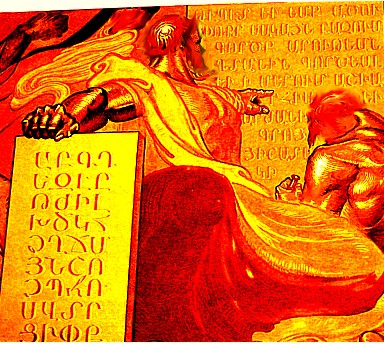
IMMORTAL SAINT MESROP MASHTOTS HOLDING THE
36 SACRED
LETTERS - MANY OF THE CHARACTERS WERE TAKEN DIRECTLY FROM THE
MEHIAN-MITHRAIC ARMENIAN ALPHABET THAT STILL SURVIVED AND WAS
USED IN THE MITHRAIC TEMPLES IN CITIES LIKE UR-HAI [ONE OF THE
ANCIENT CENTERS OF EA-HAY-HAYK-ENKI-ORION - IN THE VICINITY OF
THE 12,000 YEAR OLD WORLD'S FIRST TEMPLE...]
THE ARMENIAN SPIRIT ETERNALLY YEARNING FOR
GREATER KNOWLEDGE AND
CIVILIZATION BUILDING
Written by Gevork Nazaryan
Mesrop Maštoc‛, -- ancient Armenian word which means wise Teacher -- the words Mazda and Master -- also come from this Armenian Indo-European root word -- was an outstanding nobleman, warrior [in the spirit of the military-monastic order tradition], scholar and teacher. His greatest contribution was the revival of the use of the Armenian alphabet. The new alphabet of Maštoc‛ included ancient Armenian characters that went back to the dawn of history. The revival of the Armenian alphabet in the Vth century ushered in a new Golden Age of Armenian Literature. For his efforts in saving from complete loss the Armenian alphabet that was replaced by Greek and Syriac prior to his renewal drive, Mesrop Maštoc‛has been canonized by the Holy Apostolic Church of Armenia.
A R M E N I A N H I E R O G L Y P H S F R O M F O U R T H M I L L E N N I U M B C
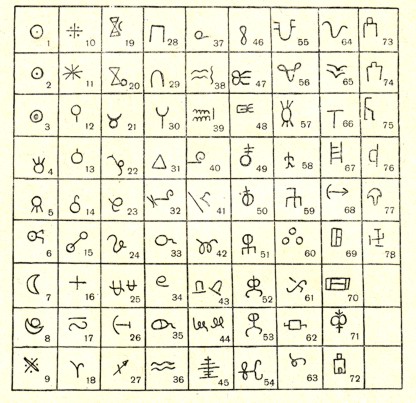
THE ZODIAC WAS INVENTED IN ARMENIAN HIGHLAND AND
THE COSMIC SYMBOLS WERE INCORPORATED INTO THE MEHIAN [MITHRAIC] SCRIPT
1. SUN, 2. ZENITH, 3. ETERNITY, 4. EAST [SUNRISE], 5. WEST
[SUNSET], 6. SOUTH,
7. MOON, 8. DAWN, 9-11. STAR, 12. EARTH, 13-15. HEAVEN, 16 AND 78. CROSS,
17. WORLD, 18. RAM, 19. MERCURY 20. 21. TAURUS [BULL], 22-24. VIŠAP
[DRAGON],
25. GEMINI [TWINS], 26-29. SAGITTARIUS [ARCHER], 30. VENUS, 31. MOUNTAIN,
32-35 AND 37, 40, 41, SOURCE [WELL, SPRING], 36. WATER, 38-39. AQUARIUS,
42. IMMORTAL, 43. DEATHLESS, 44-45. UNDECAYING, 46. HUMAN, 47-48. LEADER,
49-50. MARTYR, 51. HOSTILE, 52-54. FRIENDLY, 55-56. BROTHER, 57. WORSHIPER,
58. SON, 59. HEIR, 60. FRUIT, 61-63. ANIMAL, 64. BIRD, 65. SPRING, 66. STAFF
67. LATTER, 68. ARROW, 69-71. WAGON, 72. TOWER, 73-74. TEMPLE, 75. ROAD,
76. DOOR 77. EXTENDED [THROUGHOUT]
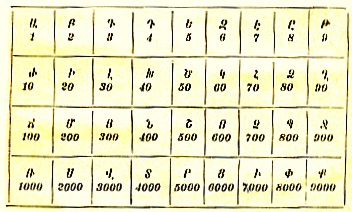
NUMERIC VALUE OF INDIVIDUAL LETTERS ASSIGNED BY MAŠTOC‛
A Y B -- FIRST LETTER -- NUM. VAL. 1
-- SEVENTH LETTER --
Ē Y [ĒA-[H]AY-A] NUM. VAL. 7 --
K‛ E -- LAST -- THIRTY-SIXTH LETTER -- NUM. VAL. 9000
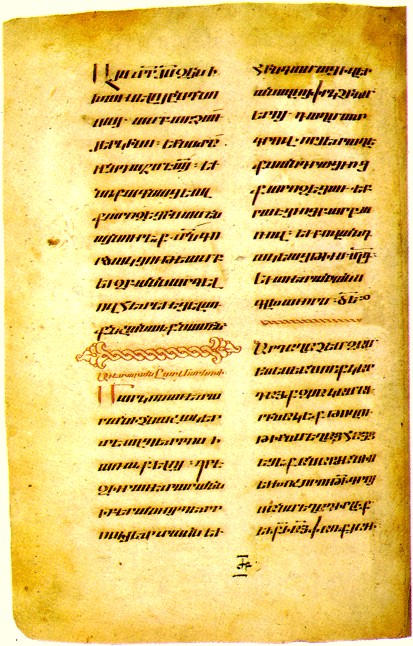
PAGE FROM THE BOOK OF GOSPELS [1171] IN ERKAT'AGIR FONT.
MATENADARAN MS NO. 313, P. 130a.

OVERLAPPING UNITED 'MEN' AND 'NU'
FORMING THE COSMIC WHEEL IN
BOLORGIR FONT.

OVERLAPPING UNITED 'VEW' AND 'NU'
FORMING THE COSMIC WHEEL IN
BOLORGIR FONT.

GOSPEL MATENADARAN MS NO. 2629 P. 2a. XIIITH CENTURY.
One of his talented pupils, Koriwn, who later wrote the biography of St. Mesrop. Maštoc‛ was born in 362 in the town of Hac‛ekac‛, in the Taron province of Greater Armenia. After receiving his primary education in his native Taron, St. Mesrop, in 389, was enlisted in the royal garrison in the capital city of Vałaršapat. During his stay in the capital, St. Mesrop came to the realization that most of the schools and other state institutions were using foreign language scripts including Greek, Pahlavi [Parthian or middle Persian] and Syrian. Greek and Syrian were spoken among the priestly class and were regarded as the Christian languages for preaching mass to the masses.
AT THE FEET OF THE GREAT MASTER....
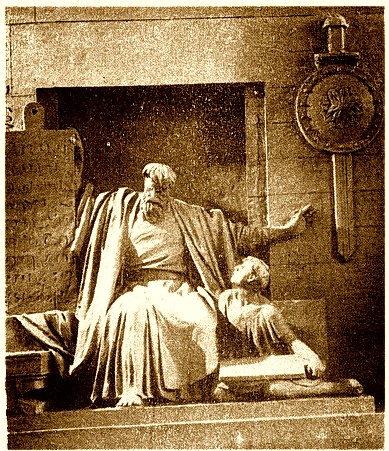
ST. MAŠTOC‛ WITH
YOUNG KORIWN [LIT. CUB] -- HIS BELOVED PUPIL WHO
LATER WROTE THE LIFE OF MAŠTOC‛
-- THE BIOGRAPHY OF THE GREAT TEACHER

The Royal Court used Greek and Parthian, which were regarded as the official languages of the Court. These languages gradually were making their way in to the spoken language. The virtually lost Armenian Mehian [Mihrian -- named after the Armenian Solar deity and Armenian Mithraism that later spread throughout the Roman Empire] alphabet was kept by a few high priests in the ruins of destroyed and deserted pre-Christian National Wisdom Temples. Throughout the fourth century, a vast amount of knowledge and civilization was destroyed included within sacred temples, monuments, scriptures, books and anything and everything that reminded the early Christians of the national past was destroyed since it was regarded as "unholy."
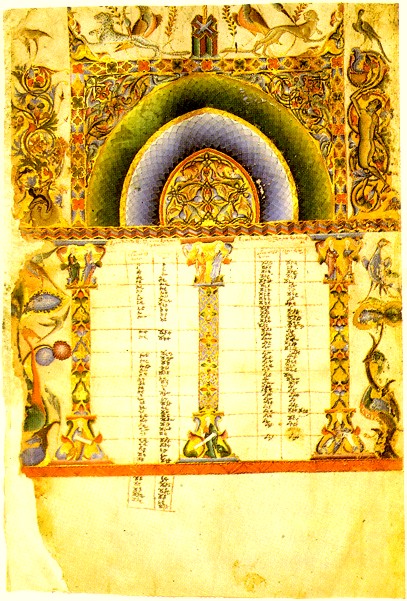
GOSPEL MATENADARAN MS NO. 9422 P. 5b[XIIITH CENTURY]. XORAN CANON
6.
An important note must be made that this is not the norm today, in fact the Mother Church of the Holy See as an important historic relic preserved the Mehian fire altar that was uncovered underneath the Mother Cathedral of Holy Etchmiadzin during archaeological excavations n the middle of the XXth century -- with the blessing of His Holiness the late Catholicos Vazgen I -- and visitors are welcome to visit the altar] St. Mesrop saw all too well the potential danger that could quickly turn into a disastrous situation. He also predicted the downfall of the monarchy in the face of unruly, power-hungry nobles.
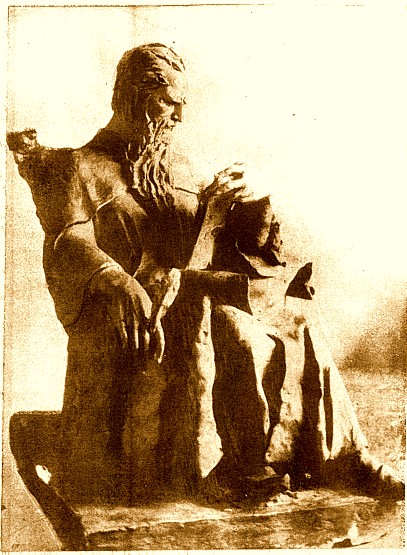
M. X O R
Ē N A C‛ I. K‛ E R T O
Ł A H A Y R -- T H E F I F T H C E N T U R Y
F A T H E R
O F A R M E
N I A N H I
S T O R Y
Mowses Xorēnac‛i the father of Armenian History, wrote, "Seeing that the end of the monarchy was near, St. Mesrop took upon himself the task and the responsibility [of the revival of the alphabet]." Maštoc‛ knew that the alphabet would serve as the greatest factor of defending the national identity and the self-determination of his people against forcible assimilation by Iran or the Byzantine Empire.

M E H I A N S C R O L L S
WERE SEALED WITH THE ZODIAC SIGIL